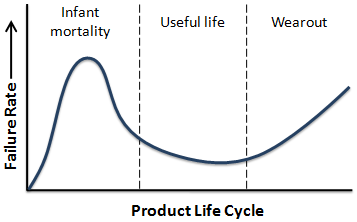FMEA stands for failure mode and effect analysis. FMEA is used to improve reliability, avoid costs, and shorten lead times. FMEA is versatile in that its principles and techniques can be applied to virtually any product or process, making it a valuable tool for companies in any industry. FMEA is a structured procedure for identifying and preventing as many potential failure modes as possible. By eliminating failure modes, FMEA improves the reliability of the product.
Relationship to Quality Function Deployment (QFD)
- QFD and FMEA are both quality planning techniques
- A QFD study identifies product characteristics that are of the greatest importance to the customer
- FMEA helps reduce the number of potential failure modes associated with those key product characteristics.
Types of FMEA
Approach
FMEA addresses the following issues:
- What function(s) is the product supposed to perform?
- How could the product failu to perform the function(s)?
- What effect would the failure have on the end product and the end user?
- How severe is the effect?
- What could cause the failure?
- How likely is the cause to actually result in the failure mode?
- What is being done to prevent or detect the cause?
- How effective is this prevention or detection method?
- What is the overall risk associated with the failure mode?
- What corrective actions can be taken to eliminate the cause of the failure, or to improve the prevention or detection measure, and thus reduce the risk?
FMEA helps ensure the reliability of the key product characteristics identified by QFD.
An FMEA may take the form of a table, graph, or matrix.
Benefits
FMEA reduces the number of product failures experienced by the customer.
Over the life cycle of a product, failures occur in a predictable pattern known as the bathtub curve:
 The source of the failures and the rate at which they occur change over time, giving rise to three distinct periods: infant mortality, useful life, and wearout.
The source of the failures and the rate at which they occur change over time, giving rise to three distinct periods: infant mortality, useful life, and wearout.
Cost avoidance
- Fewer engineering changes
- Less scrap and rework
- Less time and dollars spent troubleshooting
- Reduced sales and marketing costs
- Reduced order processing and delivery costs
- Reduced installation and service costs
- Reduced product warranty costs
- Reduced potential for liability suits
Versatile
- Can be applied to any product in any industry
- Does not require extensive formal training
- Based on logic and intuition, rather than mathematical formulas
- Useful to individuals from all disciplines
Cost effective
FMEA is a small addition to the design phase workload, with the potential to greatly impact succeeding phases of the product development cycle.
Engineers already perform some kind of failure analysis on their design; FMEA simply provides more discipline and structure to the activity.
- A person might say, "FMEA is too subjective." Some individuals may distrust a technique that relies on intuition and logic, rather than hard data. Emphasize that the strength of FMEA lies in the diverse experience and professional expertise of the team members. Their careful analysis of a product or process design may identify potential problems that mathematical approaches would fail to reveal.
- A perosn might say, "We can't spare the people for a review team." An FMEA should not be done by one person alone. Although an individual can make a difference, rarely does one person have enough knowledge or experience to understand everything about a product or process. An FMEA is most effective when people from all development-related functions pool their skills, talents, and experience. Another advantage: team members provide mutual support if commitemnt and enthusiasm start to lag.
- A person might say, "We have a tight schedule. There is no time to do an FMEA." In fact, an FMEA can save time in the long run. It fosters better communication among the different development-related functions. As a result, potential problems are identified and eliminated early, before they require time-consuming engineering changes or other remedial measures.
FMEA can be applied to any product or process in any industry. It is most effective when applied to new products or processes. It is also used for existing products or processes that are undergoing a major design change which could affect their reliability.
Key Elements of an Effective FMEA
- Timeliness - FMEA is performed early in the product development cycle.
- Teamwork - The product or process design is reviewed by a team of individuals with diverse experience and expertise.
- Documentation - The analysis is recorded on a special form. It is a "living document" which is updated as needed throughout the life of the product. The purpose of FMEA is not simply to complete the form; the form is a tool that helps provide new insights about the product or process.
Requirements for FMEA Success
- Management commitment to FMEA is the minimum requirement; company-wide support is ideal.
- The review team must understand and support the purpose and goals of FMEA.
- Maintain continuity by keeping the team together; do not continually rotate or replace members.
- Provide team members with as much information about the product or process as possible.

